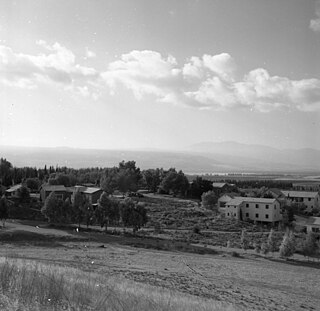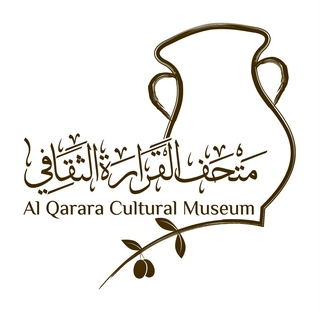Related Research Articles

The Gaza Strip, also known simply as Gaza, is a small territory located on the eastern coast of the Mediterranean Sea; it is the smaller of the two Palestinian territories, the other being the West Bank, that make up the State of Palestine. Inhabited by mostly Palestinian refugees and their descendants, Gaza is one of the most densely populated territories in the world. An end of 2024 estimate puts the population of the Strip at 2.1 million. Gaza is bordered by Egypt on the southwest and Israel on the east and north. The territory has been under Israeli occupation since 1967.

Yavne is a city in the Central District of Israel. In 2022, it had a population of 56,232.

Jabalia, also spelled Jabalya, is a city in the State of Palestine located 4 kilometers (2.5 mi) north of Gaza City, in the North Gaza Governorate of the Gaza Strip. According to the Palestinian Central Bureau of Statistics, Jabalia had a population of 172,704 in 2017. The Jabalia refugee camp is adjacent to the city to the north. The nearby town of Nazla is a part of the Jabalia municipality.

Deir al-Balah or Deir al Balah is a Palestinian city in the central Gaza Strip and the administrative capital of the Deir al-Balah Governorate of the State of Palestine. It is located over 14 kilometers (8.7 mi) south of Gaza City. The city had a population of 75,132 in 2017. The city is known for its date palms, after which it is named.

Kissufim is a kibbutz in the northwestern Negev desert in Israel. Located adjacent to the Gaza Strip at an altitude of 92 meters above sea level, it falls under the jurisdiction of Eshkol Regional Council. In 2022 it had a population of 294.

The Jericho synagogue is a Jewish synagogue, located in Jericho, in the State of Palestine. The synagogue was built in the Byzantine Empire-era and is believed to date from the late 6th or early 7th century CE and was discovered in 1936. All that remains from the ancient prayer house is its mosaic floor, which contains an Aramaic inscription presenting thanks to the synagogue donors, and a well-preserved central medallion with the inscription "Shalom al Israel", meaning "Peace [up]on Israel". This led to the site also being known as Shalom Al Israel Synagogue.
Anthedon, also referred to as Al-Balakhiyya, was a Hellenistic city near Gaza. It was first mentioned by Josephus as a city conquered by Alexander Jannaeus alongside Raphia. Pompey removed it from Jewish rule during his conquest of Judaea. Gabinius re-founded and repopulated the city, and later, Augustus incorporated Anthedon into Herod's realm, along with other coastal cities. Herod renamed it Agrippias or Agrippeion in honor of Agrippa, but the name did not endure.

Bureij is a Palestinian refugee camp located in the central Gaza Strip east of the Salah al-Din Road in the Deir al-Balah Governorate. The camp's total land area is 529 dunums and in 2017, it had a population of 28,024 with 28,770 registered refugees. The Palestinian Central Bureau of Statistics (PCBS) 2017 census listed a population of 15,491 in the surrounding Bureij municipality apart from the camp population.

Magen is a kibbutz in southern Israel. Located in the north-western Negev desert and covering 8,500 dunams, it falls under the jurisdiction of Eshkol Regional Council. In 2022, it had a population of 540.

Sufa is a kibbutz in southern Israel. Located in the Hevel Shalom area of the north-western Negev desert, it falls under the jurisdiction of Eshkol Regional Council. In 2022 it had a population of 233.

Early Byzantine mosaics in the Middle East are a group of Christian mosaics created between the 4th and the 8th centuries in ancient Syria, Palestine and Egypt when the area belonged to the Byzantine Empire. The eastern provinces of the Eastern Roman Empire and its continuation, the Byzantine Empire, inherited a strong artistic tradition from pagan Late Antiquity. The tradition of making mosaics was carried on in the Umayyad era until the end of the 8th century. The great majority of these works of art were later destroyed but archeological excavations unearthed many surviving examples.
Juhor ad-Dik is a Palestinian farming village in the Gaza Governorate, south of Gaza City, in the central Gaza Strip. According to the Palestinian Central Bureau of Statistics (PCBS), the village had a population of 4,586 inhabitants in 2017. This area is controlled by Israel due to the Israel–Hamas war. In May, 2024, the Washington Post reported that the village had been destroyed in order to construct the Netzarim Corridor.

The Gaza synagogue is a former ancient Jewish synagogue that was built in the early 6th century during the Byzantine period and destroyed in the first half of the 7th century. It was located in the ancient port city of Gaza, then known as "Maiumas", currently the Rimal district of Gaza City, in the State of Palestine. The archaeological ruins of the former synagogue were discovered in 1965. The 6th-century mosaics that led to the identification of the building as a synagogue were removed and later displayed at the Israel Museum and the Museum of the Good Samaritan.

Hamas has governed the Gaza Strip in Palestine since its takeover of the region from rival party Fatah in June 2007. Hamas' government was led by Ismail Haniyeh from 2007 until February 2017, when Haniyeh was replaced as leader of Hamas in the Gaza Strip by Yahya Sinwar. Until October 2024, Yahya Sinwar was the leader of Hamas in the Gaza Strip. In January 2024, due to the ongoing Israel–Hamas war, Israel said that Hamas lost control of most of the northern part of the Gaza Strip. In May 2024, Hamas regrouped in the north.
This page lists major archaeological events of 2017.
This page lists major events of 2020 in archaeology.
This page lists significant events of 2022 in archaeology.

The Al Qarara Cultural Museum was a museum in al-Qarara, near Khan Yunis, in the Gaza Strip. Founded in 2016, the museum featured the archaeology and history of the area, collected by its founders and by local community members. It was destroyed by Israeli forces in October 2023.

The Byzantine Church in the Gaza Strip, which today is the remains of a Christian church, includes graves and mosaic floors surrounded by marble columns on an area of 850 square meters, including 400 meters paved with mosaics. It is more than 1,700 years old, and has lived through 24 Byzantine emperors and 14 Muslim caliphs from the two Abbasid states since its inception. And the Umayyads.

The Ard-al-Moharbeen necropolis was a Roman cemetery in the Gaza Strip, Palestine. It is the largest cemetery to have been discovered in Gaza and is thought to have been in use from the 1st century BC to the 2nd century AD. The necropolis was discovered in 2022 and excavated in 2023.
References
- 1 2 3 4 "Ornate Byzantine floor mosaic discovered by Palestinian farmer". The Guardian. Reuters. 19 September 2022. Archived from the original on 2023-04-07. Retrieved 2023-10-13.
- 1 2 Escalante-De Mattei, Shanti (20 September 2022). "Palestinian Farmer Unearths 1,500-Year-Old Byzantine Mosaic in the Gaza Strip". ARTnews.com. Archived from the original on 2023-05-30. Retrieved 2023-10-13.
- ↑ Velie, Elaine (21 September 2022). "Palestinian Farmer Accidentally Unearths Intact Byzantine Mosaic". Hyperallergic. Archived from the original on 2023-07-27. Retrieved 2023-10-13.
- 1 2 3 4 "Photos: Byzantine mosaics discovered under Gaza farm". www.aljazeera.com. Archived from the original on 2023-05-27. Retrieved 2023-10-13.